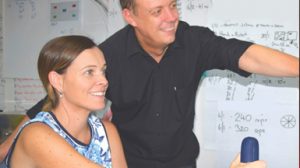Robotic arms spells new hope for patients

Brighton rehabilitation Clinical Lead physiotherapist Paul Bew and Senior Occupational Therapist Melanie Carter test the inMotion robotic upper limb retraining system.
The InMotion robotics project, in collaboration with Australian Catholic University, involves implementation and evaluation of an upper limb robotic device in the
management of upper limb weakness following stroke. The principle focus of this work is to embed the use of robotics into clinical practice as part of a comprehensive training program for people following stroke.
According to Brighton Clinical Lead physiotherapist Paul Bew, every 10 minutes someone in Australia has a stroke, and 80 per cent of those who do will experience some degree of arm weakness afterwards.
“Of these people, 50 per cent regain no useful function in that arm, and many stroke survivors have very little or no movement return,” he says.
“However it is now clear that a person’s brain and nervous system is able to change itself, and the driver for this change within the nervous system is repetition,
intensive training and practice of functional tasks.
“As the cliché states, it’s a case of ‘use it or lose it’, and the reality is if a person’s arm is too weak for any movement, intensive training is often very difficult – if not impossible.
“This robotic device enables such intensive training.”
Ever since Brighton Health Campus won the competitive tender for the project and the device, funded through Queensland Health’s New Technology Funding and Evaluation Program, senior rehabilitation physiotherapist Dr Ann Rahmann says there’s been no looking back.
“We already have about five or six patients a day using it for about 45 minutes each, and they seem to really enjoy working with it,” she says.
“The beauty of the device is that a patient with a very weak upper limb can independently exercise using the InMotion system. This means the therapists don’t need to physically assist them to practice, which makes it clinically quite time efficient.
“More importantly, patients who use it are able to complete 600-800 repetitions of exercises in one session, which is an appropriate volume of practice to
drive those changes in the brain and nervous system.”
The device is currently used solely by stroke patients, in accordance with evidence, however Ann says there is potential to expand use of the arm into other
clinical areas to help treat other conditions where clinically appropriate.
